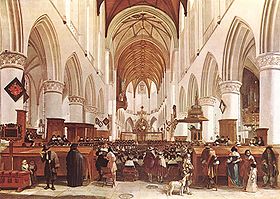
Gerrit Adriaenszoon Berckheyde
Encyclopedia

Dutch Golden Age
The Golden Age was a period in Dutch history, roughly spanning the 17th century, in which Dutch trade, science, military and art were among the most acclaimed in the world. The first half is characterised by the Eighty Years' War till 1648...
painter, active in Haarlem
Haarlem
Haarlem is a municipality and a city in the Netherlands. It is the capital of the province of North Holland, the northern half of Holland, which at one time was the most powerful of the seven provinces of the Dutch Republic...
, Amsterdam
Amsterdam
Amsterdam is the largest city and the capital of the Netherlands. The current position of Amsterdam as capital city of the Kingdom of the Netherlands is governed by the constitution of August 24, 1815 and its successors. Amsterdam has a population of 783,364 within city limits, an urban population...
, and The Hague
The Hague
The Hague is the capital city of the province of South Holland in the Netherlands. With a population of 500,000 inhabitants , it is the third largest city of the Netherlands, after Amsterdam and Rotterdam...
, who is best known today for his cityscape
Cityscape
A cityscape is the urban equivalent of a landscape. Townscape is roughly synonymous with cityscape, though it implies the same difference in urban size and density implicit in the difference between the words city and town. In urban design the terms refer to the configuration of built forms and...
s.
Biography
.jpg)
Job Adriaenszoon Berckheyde
Job Adriaenszoon Berckheyde was a Dutch artist of the 17th century, active in Haarlem, Amsterdam, and The Hague.-Biography:...
. Golden-age historian Arnold Houbraken
Arnold Houbraken
Arnold Houbraken was a Dutch painter and writer from Dordrecht, now remembered mainly as a biographer of artists from the Dutch Golden Age. He had ten children. His son Jacobus Houbraken was an engraver of portraits and book illustrations, including books by his father...
claimed that Job had been trained as a bookbinder by his father, and could not discover who taught him to paint. Gerrit in turn learned from his older brother. Job's teacher must have been a Haarlem master, and some claim it was Frans Hals
Frans Hals
Frans Hals was a Dutch Golden Age painter. He is notable for his loose painterly brushwork, and helped introduce this lively style of painting into Dutch art. Hals was also instrumental in the evolution of 17th century group portraiture.-Biography:Hals was born in 1580 or 1581, in Antwerp...
, but Houbraken claimed he travelled as a journeyman between Leiden and Utrecht offering his services as a portrait painter and learned by doing. During the 1650s the two brothers made an extended trip along the Rhine to Germany
Germany
Germany , officially the Federal Republic of Germany , is a federal parliamentary republic in Europe. The country consists of 16 states while the capital and largest city is Berlin. Germany covers an area of 357,021 km2 and has a largely temperate seasonal climate...
, stopping off at Cologne
Cologne
Cologne is Germany's fourth-largest city , and is the largest city both in the Germany Federal State of North Rhine-Westphalia and within the Rhine-Ruhr Metropolitan Area, one of the major European metropolitan areas with more than ten million inhabitants.Cologne is located on both sides of the...
, Bonn
Bonn
Bonn is the 19th largest city in Germany. Located in the Cologne/Bonn Region, about 25 kilometres south of Cologne on the river Rhine in the State of North Rhine-Westphalia, it was the capital of West Germany from 1949 to 1990 and the official seat of government of united Germany from 1990 to 1999....
, Mannheim
Mannheim
Mannheim is a city in southwestern Germany. With about 315,000 inhabitants, Mannheim is the second-largest city in the Bundesland of Baden-Württemberg, following the capital city of Stuttgart....
and finally Heidelberg
Heidelberg
-Early history:Between 600,000 and 200,000 years ago, "Heidelberg Man" died at nearby Mauer. His jaw bone was discovered in 1907; with scientific dating, his remains were determined to be the earliest evidence of human life in Europe. In the 5th century BC, a Celtic fortress of refuge and place of...
. The brothers worked in Heidelberg for Charles I Louis, Elector Palatine
Charles I Louis, Elector Palatine
Charles Louis, , Elector Palatine KG was the second son of Frederick V of the Palatinate, the "Winter King" of Bohemia, and his wife, Princess Elizabeth, daughter of King James I of England ....
, where they were both awarded a golden medal for their efforts, but were ultimately unable to adapt to court life and so returned to Haarlem, where they shared a house and studio. Gerrit became a member of the Haarlem Guild of Saint Luke on 27 July 1660. He was followed by the painter Adriaen Oudendijck
Adriaen Oudendijck
Adriaen Oudendijck , was a Dutch Golden Age landscape painter.-Biography:According to Houbraken he copied the cattle in his landscapes after leading landscape artists such as the painter Adriaen van de Velde and the figures after leading portrait painters such as Thomas Wyck, and this copycat...
.
Works

Jan van der Heyden
Jan van der Heyden was a Dutch Baroque-era painter, draughtsman, printmaker, a mennonite and inventor who significantly contributed to contemporary firefighting. He improved the fire hose in 1672, with his brother Nicolaes, who was a hydraulic engineer...
, did.
External links
- Gerrit Adriaensz Berkheyde on ArtnetArtnetartnet is an online service provider for the international art market with headquarters in New York, Berlin and Paris. Additionally, artnet has regional offices in China, the UK and Russia.- Business model :...
- Web Gallery of Art
- Art 4 Today
- Works and literature

